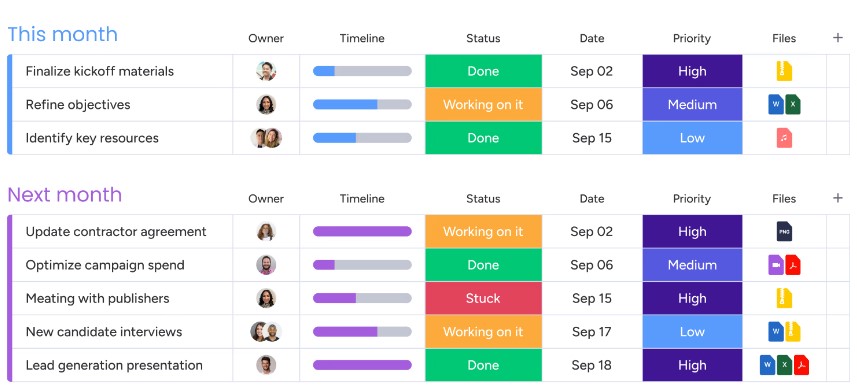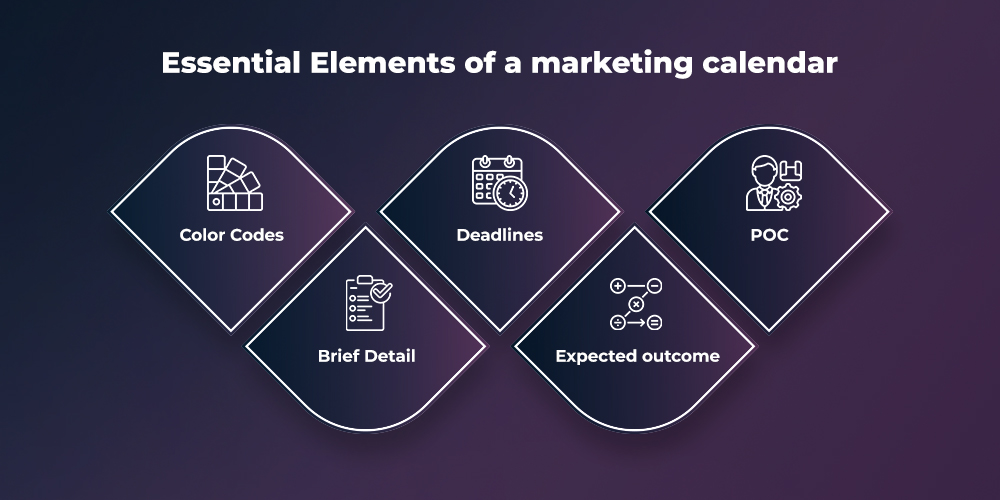Marketing is undoubtedly an essential part of any business in an industry. In order to make a brand prominent and successful, marketers put in neverending efforts, and to make sure that these efforts bring results especially for year 2024, they have to be streamlined and well-planned. The marketing calender comes into play exactly for the same reason.
Random activities fail to bring results. Here, a marketing calendar ensures that each activity is streamlined and well-planned, and every buck invested brings in results. Now, the problem is a it may go wrong due to a lack of planning – often, it remains flawed with lots of scopes of improvements. As a result, the marketing of the company goes in vain – just imagine how huge the loss will be.
Marketing helps the brand to be Visible with promotion, get Traffic, generate Sales, and improper marketing planning can be a barrier to meet these goals. A marketing calendar is where one can preview the upcoming activities a company is going to perform and modify the glitches (if any). So, an impactful marketing calendar is essential here to welcome business results.
Table of Contents
- What Is A Marketing Calendar? How Does It Look?
- Why Should You Pre-Plan Your Marketing Activities For The Entire Year?
- Aim Of Marketing Calendar In Different Stages Of User Journey
- How To Build A Marketing Calendar For Your Business?
- Protips To Design A Marketing Plan That Shows Results
- Essential Elements Of Mobile App Marketing Calendar
- Where Can You Build Your Marketing Calendar?
- A Marketing Calendar Is A Key To Profitable Business
What Is A Marketing Calendar in 2024? How Does It Look?

Marketing calendar lists chronologically (date-wise) every marketing effort of the company in a very organized and planned way. By every means, it ensures that a business creates awareness, acquires customers, and retains them in the long run.
Basically, a marketing calendar allows marketers to preplan all their activities so that they can stay competitive and achieve all their goals easily.
Finding out how it looks?

Here is a sample marketing calendar (monthly view), here one can see
- Task name
- Assignee
- Due date
- Priority
- Budget
- Estimated time
- Time taken to complete the task
- Task status
Along with this, a date view is also available, where all the details will be displayed for each day’s tasks.
Types of Marketing Calendars
Today, companies mostly include content planning, SEO activities, SMM activities, and email planning inside their marketing calendar in separate sheets.
However, maintaining separate sheets for each activity is a smart idea to maintain clearer copies. It helps anyone coming across the calendar to understand the marketing strategy specifically.
Therefore, it is advised to make separate calendars for specific marketing activities:
| Name | Contents |
| Content calendar |
|
| SEO calendar |
|
| Email campaign calendar |
|
| Video marketing calendar |
|
| SMM calendar |
|
Why Should You Pre-Plan Your Marketing Activities For The Entire Year?

Now, you may wonder why you should even pre-plan a marketing calendar? You can simply go with the flow and provide whatever is needed at times, right?
Well, that’s not the case!
Did you know that companies spend 7-10% of their overall revenue on marketing? However, this money will be of no use unless your marketing calendar is well-planned, so, planning is essential!
Let’s understand the benefits and importance of a marketing calendar specifically:
1. To Stay Consistent And Organized
Marketing calendar enables the entire team to be aware of their workload for the entire week/month/quarter. As a result, they can manage all their work in time to meet the deadline.
Also, it gives all your users an organized and consistent picture of your brand. Through your marketing activities, they get updates about your brand. And a marketing calendar helps to list these activities in the perfect order so that users find you consistent. Along with understanding what’s happening and what’s new, your users will form a positive image of your brand. So you can remain profitable.
Amazon, in 2022, used a high-runner strategy to market its product. In their marketing calendar, active promotion of the high-demand products was very consistent, which resulted in $513.98 billion revenue with a marketing spend of around $42.2 billion.
2. To Get Clarity On Resources
While forming the marketing calendar, the strategist becomes aware of available resources. For example, the marketing strategist understands the POC for each task, their forte, and how long they take to complete each task.
It helps the marketing strategist to assign the exact task to the ideal person to minimize the time to complete each task. Unless a person has the clarity of the resources, the work may get assigned to the wrong person. As a result, it gets delivered with error, increasing the chance of reworks.
Did you know that Walmart spent almost $3.9 billion on marketing in 2022 and clocked an annual gross profit of $143.754 billion (a 3.54% increase from last year)? The key target was to utilize their resources in the best possible way.
3. To Understand Your Marketing Budget
Along with the idea of manpower, pre-planning the marketing activities help the marketing planner to have an idea of marketing spend. The person understands how much the company can spend on marketing campaigns and can list the activities accordingly.
Now, companies spend around 10% of their revenue on marketing; however, this budget may decrease if the company is smaller. The lower the marketing budget, the lesser spend on marketing activities.
Several lifestyle brands, food brands, beauty brands, and fashion brands (including Rolex, McDonald’s, Nykaa, and Coca-cola) are using solely content marketing and the art of storytelling to generate sales. And it is working like Magic.
4. To Plan Your Campaigns On Time
At present, all companies are actively engaged in marketing – so pre-planning marketing activities help companies to plan their campaigns ahead and dodge competitors.
It is now a trend to make monthly and quarterly marketing plans. So, after making the marketing calendar, include activities to pull your audience to stay ahead of your competitors.
It takes 8-12 weeks to create an effective marketing campaign, but brands like Starbucks, Nike, Netflix, etc., plan their campaigns almost 5-6 months before. After a series of brainstorming and trials, the specific deliverables are decided.
5. To Become More Visible
The ultimate marketing goal is to make you visible to your audience. Preplanning the marketing activities helps you to be visible strategically. As a result, not a single marketing activity looks irrelevant to your users.
Target generated a revenue of $30.98 billion from sales, and their marketing plan was to become more visible to the target audience first to impress them and get sales from them.
Aim Of Marketing Calendar In Different Stages Of User Journey
As you know, a visitor becomes a customer/user in 4 stages – awareness, acquisition, retention, and engagement. A marketing plan helps you to grab their attention in each stage that fastens their journey to become your customer.
Here is how it works:
| Stages | Activities to include in marketing plan |
| Awareness | Share knowledge through contents like blogs, videos, social posts, etc. which offer answers to their queries |
| Acquisition | Promote products – services to make these visible to the potential users |
| Retention | Announce deals, exclusive offers, FOMO |
| Re-engagement | Announce personalized deals, loyalty programs |
How To Build A Marketing Calendar For Your Business?
Now, to make a marketing plan that brings results, you can follow these steps:

Step 1 – Define Your Business goals
To make the best marketing calendar, start with defining your goals. For this, you need to ask the following questions to yourself:
- Who are you going to target (users/partners)?
- What promotions do you want to schedule?
- How much can you spend?
- What outcome do you expect?
- Which platforms will you use for marketing (website/social media/both)?
It will help to make a concrete marketing calendar to address your customers directly. As a result, your marketing calendar will be more successful.
Step 2 – Identify Your Target Audience
In the next step, you will need to know your target audience. You need to know to whom you will showcase your product and services. Audience identification will help you to design your marketing activities per your customers’ preferences.
As a result, reaching them and getting their attention will be easier, which will bring traffic to your store organically.
Step 3 – Check Your Budget

Now, moving on to the most important part of the marketing calendar – budget. Any part of marketing – be it the content, video, or social media, needs sufficient funds. Unless your company can allocate the amount you need to spend on marketing, you must cut your marketing activities short.
You need to know that with a limited budget, too, you can do pro-level marketing. In that case, you need to rely more on content marketing on social media platforms and word-of-mouth technique to pull traffic organic way.
Step 4 – Mark The Important Dates For Your Business
Marketing is mostly about promotion, but sometimes you need to create some special posts to make your customers happy. So, for this, you have to make the dates and plan the activities of the date before.
Here important date means
- National holidays
- Festivals
- Other important dates
On these dates, your marketing has to be related to a greeting or special offers to make the celebrations bigger. Therefore, for the promotional posts, you need to pick other dates.
Step 5 – Define Your Sales Cycle
After marking the dates, you need to determine your sales cycle to understand your content and creative requirements. A Sales cycle is the timeframe in which you aim to convert a lead into a customer.
Based on this finding, all your marketing activities need to be determined. For example, a shorter sale cycle needs frequent activities to attract visitors and lead them to purchase. On the contrary, a longer sale cycle can have lesser marketing activities.
Step 6 – Generate Content Accordingly
Now, it’s time to generate content for the activities listed in the marketing calendar. Here, you will need the help of the content marketing team to get the content for
- Blogging activities
- Sales and promotion
- Holiday campaigns
- Giveaways and contests
- Product launching
- Referrals
- Emails
- Social posts
These contents have to be preferably in layman’s language, easy to read and easy to share. Also, a link to your website or app is essential here so that the traffic can directly come to your site or download and install your app and make a purchase.
Step 7 – Make Creatives
Generating textual content will not be enough because everything has to be fast in marketing. That’s why eye-catchy creatives will be needed, especially for social media marketing.
So, get the creatives ready to enhance your social media presence. While doing this, remember to be with a specific theme to make your brand image more prominent and powerful. Also, it will indicate uniformity in all your posts.
Step 8 – Get Related Captions
As you are getting the creatives ready for social media, it will be better to get the captions ready simultaneously. Also, ensure the captions contain buzzwords related to the creative and a link to your website or app.
Step 9 – Determine The Potential Users To Send Emails
Since you have prepared the email contents before, check out the potential recipients. However, the marketers often email all – be it partners, clients, or customers.
But sending emails to everyone may not always be a good idea, and your email may end up in the trash without even being read. Therefore, it is necessary to identify the ones for whom the email or newsletter will be value-adding.
Protips To Design A Marketing Plan That Shows Results
Now, let’s move on to some pro-tips that will make your marketing calendar more and more effective:
- Be consistent – maintain the frequency
- Keep room for random events
- Select the responsible people wisely
- Be open to updates
- See your competitors
Essential Elements Of Mobile App Marketing Calendar

A marketing calendar should always contain
- Color codes – so that designer can understand the expectation
- Deadlines – so that all the assignee can provide their deliverables on time
- POC – so that any team member knows whom to reach for each task and subtask
- Brief of the task – so that everyone who comes across the it can understand the topic and outcome in brief
- Expected outcome – so that the assignees understand what purpose they need to serve by completing the task
Where Can You Build Your Marketing Calendar?
- Google calendar
- Google sheet
- MS excel
- Asana
- Coda
- Trello
Also, use of Gantt chart to develop a marketing calendar is very IN. If you are looking for the same, then you can use MS project and Project libre.
A Marketing Calendar Is A Key To Profitable Business

So, pre-planning all the marketing activities is essential to remain profitable in the longer run. Unless you plan what you will do, your activities will look very messy, and it will give your customers a bad image of your brand.
Why should you take this risk when you can stay clear and organized by making a calendar before?
So, just take the help of any of the tools mentioned above and start making your marketing calendar right now!
Make your business more profitable with the power of mobile apps. Now, just drag and drop to build your mobile app the way you want, so let’s explore the power of no-code mobile app builder today with MageNative.
About MageNative
MageNative is a leading app-building platform that facilitates app creation for business owners regardless of their knowledge of the technical nuances involved. At MageNative, we convert ideas into scalable mobile apps instantly and conveniently.
Check out the most successful Case studies of MageNative.
About The Author
I love navigating the world of SaaS with finesse. As an SEO enthusiast and seasoned Copy Writer, I'm here to transform tech-speak into compelling narratives that resonate with online merchants. With a penchant for alliteration and a touch of humor, I bring a unique flair to SaaS content.
Related Posts
What E-commerce Brands Look for in a Mobile App Theme: A Complete Industry Guide
Choosing the right mobile app theme for an e-commerce brand…
A Smarter Approach to Abandoned Cart Recovery
Abandoned cart recovery is one of the most important yet…
Turn Customer Behavior Into Sales With a Smart Data-Driven Marketing Approach
A data-driven marketing approach isn’t just a buzzword—it’s a necessity….